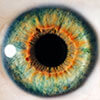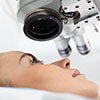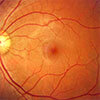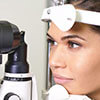Glaucoma Treatments
Variety of Glaucoma Treatments Available
Glaucoma can be treated with medicine, laser surgery, conventional surgery or a combination of procedures and medications depending on the type of glaucoma.
There is no cure for glaucoma. Treatment is designed to control the glaucoma to prevent vision loss for the rest of one’s life. Glaucoma must be monitored several times a year to assure the treatment is still effective. Often treatment must be adjusted to maintain control of the disease.
Glaucoma Filtering Surgery
Filtering Surgery an Option for More Developed Glaucoma
When eye drops or laser treatments are not enough to prevent vision loss from glaucoma, your ophthalmologist must perform glaucoma filtering surgery.
Glaucoma filtering surgery is performed in the operating room with microsurgical instruments and an operating microscope. This surgery is usually performed as an outpatient procedure under local anesthesia. Proper recovery from this type of eye surgery is slightly longer than other types of eye surgery and requires frequent post-operative visits to the ophthalmologist.
There are two basic types of glaucoma filtering surgery. During trabeculectomy surgery, your ophthalmologist creates a fluid drainage hole in the eye wall. In the other type of surgery, called canaloplasty, the doctor implants a plastic drainage device through the eye wall.
Both procedures are designed to enhance and restore the eye’s natural drainage system, while reducing eye pressure.
Canaloplasty does not penetrate into the anterior chamber of the eye, so there is less risk of the complications associated with traditional glaucoma filtering surgery. Vision recovery after canaloplasty is quicker, and with fewer activity restrictions after surgery, the patient can return to normal life more quickly.
After both types of surgery, fluid from the eye drains out of the eye to a pocket behind the eyelids and is absorbed into the bloodstream. This lowers the pressure inside the eye so damage from glaucoma can be stopped.
A certain percentage of patients will experience a gradual increase in eye pressure in the months or years following glaucoma filtering surgery. These patients will start using eye drops again t lower the eye pressure, or may require repeat surgeries to lower the pressure.
Glaucoma Laser Surgery
Two Types of Laser Surgery Help Glaucoma Patients
Laser surgery for glaucoma may be used alone or in addition to medications. Laser treatment is usually performed in the office or surgery center with topical anesthetic drops, can be completed in less than 30 minutes and involves minimal discomfort for the patient.
The most common types of laser treatment are selective laser trabeculoplasty (SLT) for open angle glaucoma and laser iridotomy for narrow angle glaucoma.
Follow-up visits are required to check for complications of laser surgery and to assess the effect of the procedure.
Laser treatment for open angle glaucoma
Open angle glaucoma may be treated with a laser in an attempt to lower the pressure inside the eye. The newest and most gentle type of laser treatment is the Selective Laser Trabeculoplasty, or SLT for short. This treatment usually involves minimal discomfort, and is completed in a few minutes with topical anesthetic drops. The laser is attached to a machine that is similar to the one that your eye doctor uses to examine your eyes. During the laser procedure, the patient sees multiple bright flashes of light, and may occasionally feel a mild stinging sensation in the eye. Usually, however, no pain is experienced by the patient.
In laser treatment for open angle glaucoma, the laser beam is directed towards the drainage area of the eye, which is called the trabecular meshwork. This is in the front part of the eye between the cornea and the iris. In some types of glaucoma, there is an invisible blockage in the trabecular meshwork which blocks the outflow of fluid, thereby increasing the pressure inside the eye. It has been discovered that treating the trabecular meshwork with a laser can lower the intraocular pressure. It is thought that the laser increases the flow of fluid through this drain.
This laser is generally effective in about eighty percent of patients who undergo the procedure. Usually the beneficial effect of the laser is not permanent, and the procedure may need to be repeated within a few years. In approximately fifty percent of patients, the laser helps to lower pressure for as long as ten years.
The most common complications of SLT include a temporary increase in the eye pressure, or inflammation inside the eye. These two complications are normally treated with eye drops and typically improve within days.
After laser treatment for open angle glaucoma, the complete effect may not be noticed until about eight weeks after the procedure. Glaucoma medications should be continued following laser treatment unless your eye doctor instructs you otherwise.
Laser treatment for narrow angle glaucoma
Click here for a printer friendly version
Narrow angle glaucoma can be treated with a laser. This laser treatment can be used to prevent an attack of narrow angle glaucoma, and it can also be used during an attack of narrow angle glaucoma, in order to lower the eye pressure. Narrow angle glaucoma involves a narrowing of the drainage area, or angle, of the eye. This narrowing is caused because the iris of the eye moves closer to the drainage area in predisposed individuals. If the iris moves so close that it closes the drainage area, then the intraocular pressure increases, and narrow angle glaucoma is the result.
In laser treatment for narrow angle glaucoma, the laser is used to create a tiny microscopic hole in the iris of the eye, called an Iridotomy, through which fluid may pass in order to reach the drain. This allows the iris to fall back away from the drainage area. This usually cures or prevents progression of narrow angle glaucoma.
This laser treatment is performed with topical anesthetic drops, and can be completed in a few minutes and it involves minimal discomfort for the patient. The laser is attached to the machine that your eye doctor uses to examine your eyes. During the laser procedure, the patient will notice multiple bright flashing lights, and may experience occasional stinging in the eye. Normally the patient does not experience any pain.
After the laser treatment, your eye doctor will ask you to stay in the office for approximately one hour so that the eye pressure can be checked. Sometimes, you may be asked to return in twenty-four hours for a repeat pressure check. Usually, you will also be asked to return in one week for a pressure check and assessment of the treatment.
Glaucoma Medications
Eye Drops, Other Medication Slow Glaucoma Progression
Using one or more eye drops daily helps lower eye pressure and prevent progression of glaucoma. Commonly used eye drops include:
- Latanoprost (Xalatan)
- Bimatoprost (Lumigan)
- Travoprost (Travatan)
- Dorzolamide (Trusopt)
- Brinzolamide (Azopt)
- Timolol (Timoptic)
- Brimonidine (Alphagan P)
Pills also may be used to lower eye pressure.
Learn more about dosage, precautions and side effects.









